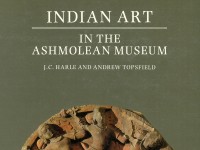Indian Art in the Ashmolean Museum
A catalogue of the Ashmolean’s collection of Indian art by J. C. Harle and Andrew Topsfield (published Oxford, 1987).

Publications online: 143 objects
- Reference URL
Actions
Casket with geometric and foliate decoration
-
Literature notes
The production of wooden furniture decorated with overlaid pieces of iridescent mother-of-pearl set in dark lac was an important luxury handicraft of Western India in the 16th and 17th centuries. Examples of the technique survive in India in the cenotaph canopies at three tombs of Sufi Shaikhs, two of them at Ahmedabad and the other in the shrine of Nitzām ud-Dīn Auliyā’ at Delhi. However much of the production was intended for export to foreign markets, including Ottoman Turkey and Europe. The approximately thirty surviving examples include a throne, a book-rest, pen-boxes, writing chests and a number of caskets with bevelled lids. One of the latter, in Dresden, has an inventory date of 1602 and displays a very similar spade-shaped tree device to the present casket, which in spite of a slight coarseness in its decoration can therefore be dated to just before 1600. Its sides are decorated with medallions containing stylised interlaced foliate decoration, interspersed with palm tress and leafy fronds. The flat surface of the lid is executed in a similar style, but its sloping sides have geometric ornament of repeated hexagons and diamonds characteristic of Ottoman work, and it has been suggested that the casket was probably made for the Ottoman market. The chinoiserie base is a later replacement. -
Description
Mother-of-pearl furniture of this kind, using the contrasting black lac to enhance the designs, was exported from Western India to Europe, Ottoman Turkey and elsewhere. Combining Islamic geometric designs with its Indian palm-tree and leafy frond decoration, this casket may have been made for the Turkish market.
-
Details
- Associated place
-
Asia › India › west India › Gujarat (place of creation)
- Date
- 1590 - 1600
- Material and technique
- wood, overlaid with mother-of-pearl and black lac or mastic
- Dimensions
- 21.5 x 31.7 x 19 cm max. (height x width x depth)
- Material index
-
organic › animal › shell › pearlshell › mother-of-pearl,organic › animal › animal product › lac,
- Technique index
- Object type index
- No. of items
- 1
- Credit line
- Purchased with the assistance of the Friends of the Ashmolean Museum, 1980.
- Accession no.
- EA1980.146
-
Further reading
Harle, J. C., and Andrew Topsfield, Indian Art in the Ashmolean Museum (Oxford: Ashmolean Museum, 1987), no. 98 on p. 88, pl. 19 (colour) & p. 88
London: Victoria and Albert Museum, 21 April-22 August 1982, The Indian Heritage: Court Life and Arts under Mughal Rule, Robert Skelton, ed. (London: Victoria and Albert Museum, 1982), no. 551 on p. 162
Impey, Oliver, and Christiaan Jörg, Japanese Export Lacquer 1580-1850 (Amsterdam: Hotei Publishing, 2005), no. 115, pp. 77-78, illus. p. 77
Oxford: Ashmolean Museum, 24 May 2006-23 December 2008, Treasures: Antiquities, Eastern Art, Coins, and Casts: Exhibition Guide, Rune Frederiksen, ed. (Oxford: Ashmolean Museum, 2006), no. 151 on p. 54, illus. p. 54
Location
Objects are sometimes moved to a different location. Our object location data is usually updated on a monthly basis. Contact the Jameel Study Centre if you are planning to visit the museum to see a particular object on display, or would like to arrange an appointment to see an object in our reserve collections.
Galleries
Publications online
-

Indian Art in the Ashmolean Museum
The production of wooden furniture decorated with overlaid pieces of iridescent mother-of-pearl set in dark lac was an important luxury handicraft of Western India in the 16th and 17th centuries. Examples of the technique survive in India in the cenotaph canopies at three tombs of Sufi Shaikhs, two of them at Ahmedabad and the other in the shrine of Nitzām ud-Dīn Auliyā’ at Delhi. However much of the production was intended for export to foreign markets, including Ottoman Turkey and Europe. The approximately thirty surviving examples include a throne, a book-rest, pen-boxes, writing chests and a number of caskets with bevelled lids. One of the latter, in Dresden, has an inventory date of 1602 and displays a very similar spade-shaped tree device to the present casket, which in spite of a slight coarseness in its decoration can therefore be dated to just before 1600. Its sides are decorated with medallions containing stylised interlaced foliate decoration, interspersed with palm tress and leafy fronds. The flat surface of the lid is executed in a similar style, but its sloping sides have geometric ornament of repeated hexagons and diamonds characteristic of Ottoman work, and it has been suggested that the casket was probably made for the Ottoman market. The chinoiserie base is a later replacement.
Notice
Object information may not accurately reflect the actual contents of the original publication, since our online objects contain current information held in our collections database. Click on 'buy this publication' to purchase printed versions of our online publications, where available, or contact the Jameel Study Centre to arrange access to books on our collections that are now out of print.
© 2013 University of Oxford - Ashmolean Museum















